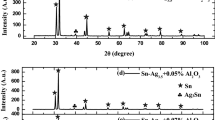Abstract
In this paper, Al nanoparticles were manually mixed into the Sn–1Ag–0.5Cu solder paste to prepare composite solder. The content of Al nanoparticles ranged from 0 to 0.4 wt% in the solders. The influences of Al nanoparticles on the melting characteristics, wettability, mechanical properties, microstructure and interfacial intermetallic growth of low-Ag Sn–1Ag–0.5Cu solders on copper substrate were investigated. Results show that added Al nanoparticles can not obviously change the melting point of the Sn–1Ag–0.5Cu solder, and improve the wettability and mechanical properties of plain Sn–1Ag–0.5Cu solder. However, excessive addition Al nanoparticles will reduce the wettability and mechanical properties of the solder. There is an optimum amount of Al nanoparticles in Sn–1Ag–0.5Cu solder, which is 0.1 wt%, and Sn–1Ag–0.5Cu–0.1Al nano-composite solder exhibit the best comprehensive properties. Based on the microstructure examination, it is found that adding Al nanoparticles can obviously refine the microstructure of Sn–1Ag–0.5Cu–xAl solder. In addition, the interfacial intermetallic compounds (IMC) layer thickness of the Sn–1Ag–0.5Cu–xAl solders are smaller than that of plain Sn–1Ag–0.5Cu solder, which indicates that Al nanoparticles can effectively suppress IMC formation and growth.













Similar content being viewed by others
References
L. Sun, L. Zhang, S.J. Zhong, J. Ma, L. Bao, Reliability study of industry Sn3.0Ag0.5Cu/Cu lead-free soldered joints in electronic packaging. J. Mater. Sci.: Mater. Electron. 26(11), 9164–9170 (2015)
L. Zhang, S.B. Xue, G. Zeng, L.L. Gao, H. Ye, Interface reaction between SnAgCu/SnAgCuCe solders and Cu substrate subjected to thermal cycling and isothermal aging. J. Alloys Compd. 510(1), 38–45 (2012)
C.L. Chuang, L.C. Tsao, H.K. Lin, L.P. Feng, Effects of small amount of active Ti element additions on microstructure and property of Sn3.5Ag0.5Cu solder. Mater. Sci. Eng. A 558, 478–484 (2012)
A.A. El-Daly, G.S. Al-Ganainy, A. Fawzy, M.J. Younis, Structural characterization and creep resistance of nano-silicon carbide reinforced Sn–1.0Ag–0.5Cu lead-free solder alloy. Mater. Des. 55, 837–845 (2014)
A.E. Hammad, Investigation of microstructure and mechanical properties of novel Sn–0.5Ag–0.7Cu solders containing small amount of Ni. Mater. Des. 50, 108–116 (2013)
F.X. Che, W.H. Zhu, E.S.W. Poh, X.R. Zhang, X.W. Zhang, T.C. Chai, S. Gao, Creep properties of Sn–1.0Ag–0.5Cu lead-free solder with Ni addition. J. Electron. Mater. 40(3), 344–354 (2011)
J.E. Spinelli, A. Garcia, Development of solidification microstructure and tensile mechanical properties of Sn–0.7Cu and Sn–0.7Cu–2.0Ag solders. J. Mater. Sci.: Mater. Electron. 25(1), 478–486 (2014)
F.J. Cheng, F. Gao, J.Y. Zhang, W.S. Jin, X. Xiao, Tensile properties and wettability of SAC307 and SAC105 low Ag lead-free solder alloys. J. Mater. Sci. 46(10), 3424–3429 (2011)
D.A.A. Shnawah, S.B.M. Said, M.F.M. Sabri, I.A. Badruddin, F.X. Che, Microstructure, mechanical, and thermal properties of the Sn–1Ag–0.5Cu solder alloy bearing Fe for electronics applications. Mater. Sci. Eng. A 551, 160–168 (2012)
H.Y. Song, Q.S. Zhu, Z.G. Wang, J.K. Shang, M. Lu, Effects of Zn addition on microstructure and tensile properties of Sn–1Ag–0.5Cu alloy. Mater. Sci. Eng. A 527(6), 1343–1350 (2010)
H.K. Cheng, C.W. Huang, H. Lee, Y.L. Wang, T.F. Liu, Interfacial reactions between Cu and SnAgCu solder doped with minor Ni. J. Alloys Compd. 622, 529–534 (2015)
K.S. Lin, H.Y. Huang, C.P. Chou, Interfacial reaction between Sn–1Ag–0.5Cu (–Co) solder and Cu substrate with Au/Ni surface finish during reflow reaction. J. Alloys Compd. 471(1–2), 291–295 (2009)
L. Yang, J.G. Ge, Y.C. Zhang, J. Dai, Y.F. Jing, Effect of BaTiO3 on the microstructure and mechanical properties of Sn1.0Ag0.5Cu lead-free. J. Mater. Sci.: Mater. Electron. 26(1), 613–619 (2015)
Y. Gu, X.C. Zhao, Y. Li, P. Liu, Y. Wang, Z.Y. Li, Effect of nano-Fe2O3 additions on wettability and interfacial intermetallic growth of low-Ag content Sn–Ag–Cu solders on Cu substrates. J. Alloys Compd. 627, 39–47 (2015)
L. Zhang, J.H. Cui, J.G. Han, Y.H. Guo, C.W. He, Microstructures and properties of SnZn–xEr lead-free solders. J. Rare Earths 30(8), 790–793 (2012)
A.K. Gain, T. Fouzder, Y.C. Chan, A. Sharif, N.B. Wong, W.K.C. Yung, The influence of addition of Al nano-particles on the microstructure and shear strength of eutectic Sn–Ag–Cu solder on Au/Ni metallized Cu pads. J. Alloys Compd. 506(1), 216–223 (2010)
P. Liu, P. Yao, J. Liu, Effect of SiC nanoparticle additions on microstructure and microhardness of Sn–Ag–Cu solder alloy. J. Electron. Mater. 37(6), 874–879 (2008)
Y. Li, X.C. Zhao, Y. Liu, Y. Wang, Y. Wang, Effect of TiO2 addition concentration on the wettability and intermetallic compounds growth of Sn3.0Ag0.5Cu–xTiO2 nano-composite solders. J. Mater. Sci.: Mater. Electron. 25(9), 3816–3827 (2014)
Acknowledgments
This work was supported by the Graduate Research and Innovation Foundation of Jiangsu Normal University (2015YZD018), National Natural Science Foundation of China (No. 51475220), the Natural Science Foundation of Jiangsu Province (BK2012144), and the State Key Laboratory of Advanced Brazing Filler Metals and Technology (Zhengzhou Research Institute of Mechanical Engineering) (SKLABFMT-2015-03).
Author information
Authors and Affiliations
Corresponding author
Rights and permissions
About this article
Cite this article
Sun, L., Zhang, L., Xu, L. et al. Effect of nano-Al addition on properties and microstructure of low-Ag content Sn–1Ag–0.5Cu solders. J Mater Sci: Mater Electron 27, 7665–7673 (2016). https://doi.org/10.1007/s10854-016-4751-7
Received:
Accepted:
Published:
Issue Date:
DOI: https://doi.org/10.1007/s10854-016-4751-7




